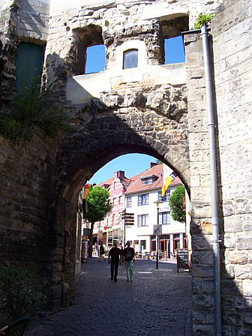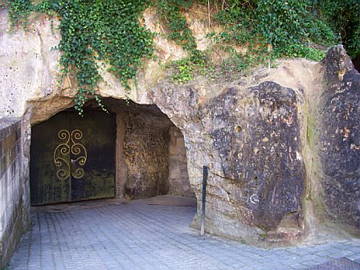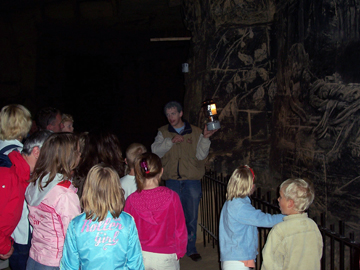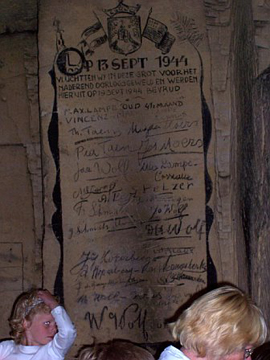|
Travels in Geology December 2007 posted December 19, 2007
The caves hidden beneath Valkenburg
Karyn Johnson
 Karyn Johnson |
The town of Valkenburg in the Netherlands near the German border offers much to visitors aboveground, from biking tours to thermal spas. However, it is what lies beneath the town that makes this area such an intriguing place to visit, and the holiday season is a great time to go.
|
Cold, crisp and decorated in an old-world fashion unparalleled anywhere, December is gorgeous in Germany and the Netherlands. And Valkenburg, a small Dutch town near the German border, is no different. Sadly, it is unknown to most tourists outside of Europe. It is certainly worth spending a day there, however, should you be in the Netherlands or Germany over the holiday season. The town is known not only for its renowned gastronomic pleasures and thermal spa, but also for the hilliest terrain in the Netherlands, which is ideal for outdoor enthusiasts. This South Limburg town attracts thousands of European tourists every year, partly for these reasons. Valkenburg's main attraction, however, lies in the dark, cool caves carved out of its marlstone cliffs, where tourists can see a variety of carvings, etchings and paintings left by generations of Valkenburg residents.
 Karyn Johnson |
The caves beneath Valkenburg have been excavated for more than 2,000 years and inhabited by various people dating back to the Roman period. The Fluweelengrot (Velvet Cave) lies beneath the ruins of a castle. A walking tour takes visitors through both. |
These caves are not just fascinating to explore, but they have also been essential to the town's survival for centuries. An examination of the labyrinthine tunnels reveals much of Valkenburg's history. Since Roman times, the marlstone — an impure limestone — has been mined for use as building material. Many of the town's buildings, most notably its castle, were built from marlstone cultivated from two areas, the Gemeentegrot (Municipal Cave) and Fluweelengrot (Velvet Cave).
In the Fluweelengrot, mining began in 1050 — when the construction of the castle started — and ended sometime around 1886. As a result, there are more than five kilometers of secret passageways that during medieval times were used to help save the castle when marauders attacked. The men living in the castle would escape out the back through these passages and attack enemies from behind. The corridors were also used to transport supplies into the castle.
The Gemeentegrot's history goes back even further, having been excavated for more than 2,000 years, beginning with the Romans. Excavations at various times have revealed layers of fossils and shells, a reminder of Valkenburg's ancient past, when it was a tropical sea that hosted many types of aquatic life some 100 million years ago. As the sea dried out and the climate changed, the dead plants and animals were preserved for eternity in the marlstone that formed from the mixture of plankton and sand. In addition to the fossils and shells, the cave walls display very different kinds of art from the past 2,000 years, a reminder of Valkenburg's more recent history.
 Karyn Johnson |
| The art in Fluweelengrot dates back at least two centuries, and includes paintings by Roman Catholic priests who hid and held services in secret chapels in the caves. Walking tours are in Dutch, but English-speakers can get a paper translation. |
The art in the Fluweelengrot is a bit different, and goes back just over two centuries. During the French occupation at the end of the 18th century, Napoleon closed down all the churches and forced Roman Catholic priests to swear allegiance to France. Those who refused were exiled. During this time, secret chapels sprung up throughout the area — one of which is inside the Fluweelengrot. Founded by Father Widdershoven in 1797, this tiny chapel was the site of many secret masses, and can still be seen today.
Another highlight in Fluweelengrot is the names carved into the walls by U.S. soldiers when they came to liberate Valkenburg from the Germans toward the end of World War II. When they arrived in the town, it was practically deserted. Eventually, they discovered that the locals, as well as some Jewish people, had been hiding in the caves. After the war ended, an artist painted the soldiers' silhouettes on the cave walls as a way of honoring them. Seeing these names and paintings is a sobering experience.
Other art works, such as Dutch royal portraits and carvings of prehistoric animals, reveal other pieces of Valkenburg's past. What is remarkable about much of this art is that it was done with very little light, yet reveals incredible detail. The paintings’ preservation is due to the damp, cool climate inside the caves, with a constant temperature of about 12 degrees Celsius (54 degrees Fahrenheit) and 90 percent humidity.
 Karyn Johnson |
| Some of the other art in Fluweelengrot includes the names of American soldiers carved into the walls during World War II, when the soldiers stayed in the caves as they liberated Valkenburg from the Germans. |
Visitors who have time to tour both caves will see something different in each. Though the Fluweelengrot has been more settled throughout the ages, it has actually retained much more of its primitiveness than the Gemeentegrot thanks to the modern tourism industry. A walking tour of the Fluweelengrot, which takes about an hour and covers more than 800 meters of its corridors, can be combined with a visit to the castle ruins above it. Although the tour is in Dutch, English speakers will get a pamphlet explaining the various sights inside the cave, and the guides also speak English and can answer questions as the tour progresses. The Gemeentegrot offers tours on foot and by tram. The tram takes half an hour, and is suitable for the disabled. The walking tour is about an hour.
The most popular time for visiting the caves is at Christmas, when both are converted into festive markets that sell gifts, food and drinks. Although beautiful all dressed up, the emphasis at this time is more on consumerism and less on the caves’ history, however. For visitors who only want to focus on the beauty of the caves, go any other time of the year, although the caves can get very crowded in the summer.
Further enjoyment of Valkenburg can be found in town, where a variety of excellent restaurants and charming shops line the cobblestone streets. Those seeking total relaxation can find it at Thermae 2000, considered one of Europe's top spas, which offers indoor and outdoor baths from two thermal springs, as well as mineral-rich fresh drinking water. Biking is also a popular activity in the region, and it’s not hard to find a cheap place to rent a bike for a day.
Valkenburg is located near the Dutch town of Maastricht, one of the Netherlands' oldest cities, which is a good place from which to base your visit to the caves, or worth a visit on its own. Maastricht hosts one of the Netherlands’ biggest sea barriers, which close to block the North Sea when bad storms approach. It’s an engineering feat worth seeing if you’re in the area. The Belgian and German borders are also a very short drive away, offering a wealth of interesting sights and activities, as well as good food and good beer — what more could a geologist want?
Links:
South Limburg Tourism
Valkenburg Tourism
Fluweelengrot
Gemeentegrot
Thermae 2000
Back to top

 Subscribe
Subscribe


